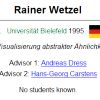| |
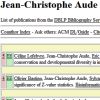   
Jean-Christophe Aude,
Yolande Diaz-Lazcoz,
Jean-Jacques Codani and
Jean-Loup Risler. Applications of the Pyramidal Clustering Method to Biological Objects. In CC, Vol. 23(3-4):303-315, 1999.
Keywords: from distances, phylogenetic network, phylogeny, Program Pyramids, pyramid, reconstruction, software, visualization.
Note: http://dx.doi.org/10.1016/S0097-8485(99)00006-6.
|
|
| |
|
| |
  
Mark Clement,
David Posada and
Keith A. Crandall. TCS: a computer program to estimate gene genealogies. In MOLE, Vol. 9:1657-1659, 2000.
Keywords: from sequences, parsimony, phylogenetic network, phylogeny, Program TCS, reconstruction, software, statistical parsimony.
Note: http://darwin.uvigo.es/download/papers/08.tcs00.pdf.
Toggle abstract
[No abstract available]
|
|
| |
  
Andreas W. M. Dress,
Daniel H. Huson and
Vincent Moulton. Analyzing and visualizing distance data using SplitsTree. In DAM, Vol. 71(1):95-109, 1996.
Keywords: abstract network, from distances, phylogenetic network, phylogeny, Program SplitsTree, software, split network, visualization.
Note: http://bibiserv.techfak.uni-bielefeld.de/splits/splits.pdf.
|
|
| |
 
Philippe Gambette and
Daniel H. Huson. Improved Layout of Phylogenetic Networks. In TCBB, Vol. 5(3):472-479, 2008.
Keywords: abstract network, heuristic, phylogenetic network, phylogeny, Program SplitsTree, software, split network, visualization.
Note: http://hal-lirmm.ccsd.cnrs.fr/lirmm-00309694/en/.
Toggle abstract
"Split networks are increasingly being used in phylogenetic analysis. Usually, a simple equal-angle algorithm is used to draw such networks, producing layouts that leave much room for improvement. Addressing the problem of producing better layouts of split networks, this paper presents an algorithm for maximizing the area covered by the network, describes an extension of the equal-daylight algorithm to networks, looks into using a spring embedder, and discusses how to construct rooted split networks. © 2008 IEEE."
|
|
| |
   
Stefan Grünewald,
Kristoffer Forslund,
Andreas W. M. Dress and
Vincent Moulton. QNet: An agglomerative method for the construction of phylogenetic networks from weighted quartets. In MBE, Vol. 24(2):532-538, 2007.
Keywords: abstract network, circular split system, from quartets, phylogenetic network, phylogeny, Program QNet, reconstruction, software.
Note: http://mbe.oxfordjournals.org/cgi/content/abstract/24/2/532.
Toggle abstract
"We present QNet, a method for constructing split networks from weighted quartet trees. QNet can be viewed as a quartet analogue of the distance-based Neighbor-Net (NNet) method for network construction. Just as NNet, QNet works by agglomeratively computing a collection of circular weighted splits of the taxa set which is subsequently represented by a planar split network. To illustrate the applicability of QNet, we apply it to a previously published Salmonella data set. We conclude that QNet can provide a useful alternative to NNet if distance data are not available or a character-based approach is preferred. Moreover, it can be used as an aid for determining when a quartet-based tree-building method may or may not be appropriate for a given data set. QNet is freely available for download. © The Author 2006. Published by Oxford University Press on behalf of the Society for Molecular Biology and Evolution. All rights reserved."
|
|
| |
  
Stefan Grünewald,
Vincent Moulton and
Andreas Spillner. Consistency of the QNet algorithm for generating planar split networks from weighted quartets. In DAM, Vol. 157(10):2325-2334, 2009.
Keywords: abstract network, consistency, from quartets, phylogenetic network, phylogeny, Program QNet, reconstruction, software.
Note: http://dx.doi.org/10.1016/j.dam.2008.06.038.
Toggle abstract
"Phylogenetic networks are a generalization of evolutionary or phylogenetic trees that allow the representation of conflicting signals or alternative evolutionary histories in a single diagram. Recently the Quartet-Net or "QNet" method was introduced, a method for computing a special kind of phylogenetic network called a split network from a collection of weighted quartet trees (i.e. phylogenetic trees with 4 leaves). This can be viewed as a quartet analogue of the distance-based Neighbor-Net (NNet) method for constructing outer-labeled planar split networks. In this paper, we prove that QNet is a consistent method, that is, we prove that if QNet is applied to a collection of weighted quartets arising from a circular split weight function, then it will return precisely this function. This key property of QNet not only ensures that it is guaranteed to produce a tree if the input corresponds to a tree, and an outer-labeled planar split network if the input corresponds to such a network, but also provides the main guiding principle for the design of the method. © 2008 Elsevier B.V. All rights reserved."
|
|
| |

Jotun Hein. A heuristic method to reconstruct the history of sequences subject to recombination. In JME, Vol. 36(4):396-405, 1993.
Keywords: explicit network, from sequences, heuristic, parsimony, phylogenetic network, phylogeny, Program RecPars, recombination, recombination detection, software.
Note: http://dx.doi.org/10.1007/BF00182187.
|
|
| |
    
Katharina Huber,
Michael Langton,
David Penny,
Vincent Moulton and
Mike Hendy. Spectronet: A package for computing spectra and median networks. In ABIO, Vol. 1(3):159-161, 2004.
Keywords: from splits, median network, phylogenetic network, phylogeny, Program Spectronet, software, split, visualization.
Note: http://citeseer.ist.psu.edu/631776.html.
Toggle abstract
Spectronet is a package that uses various methods for exploring and visualising complex evolutionary signals. Given an alignment in NEXUS format, the package works by computing a collection of weighted splits or bipartitions of the taxa and then allows the user to interactively analyse the resulting collection using tools such as Lento-plots and median networks. The package is highly interactive and available for PCs.
|
|
| |
   
Katharina Huber,
Bengt Oxelman,
Martin Lott and
Vincent Moulton. Reconstructing the Evolutionary History of Polyploids from Multilabeled Trees. In MBE, Vol. 23(9):1784-1791, 2007.
Keywords: duplication, explicit network, from multilabeled tree, from trees, phylogenetic network, phylogeny, Program PADRE, reconstruction, software.
Note: http://mbe.oxfordjournals.org/cgi/content/full/23/9/1784.
Toggle abstract
"In recent studies, phylogenetic networks have been derived from so-called multilabeled trees in order to understand the origins of certain polyploids. Although the trees used in these studies were constructed using sophisticated techniques in phylogenetic analysis, the presented networks were inferred using ad hoc arguments that cannot be easily extended to larger, more complicated examples. In this paper, we present a general method for constructing such networks, which takes as input a multilabeled phylogenetic tree and outputs a phylogenetic network with certain desirable properties. To illustrate the applicability of our method, we discuss its use in reconstructing the evolutionary history of plant allopolyploids. We conclude with a discussion concerning possible future directions. The network construction method has been implemented and is freely available for use from http://www.uea.ac.uk/ ∼a043878/padre.html. © The Author 2006. Published by Oxford University Press on behalf of the Society for Molecular Biology and Evolution. All rights reserved."
|
|
| |
|
| |
 
Daniel H. Huson and
David Bryant. Application of Phylogenetic Networks in Evolutionary Studies. In MBE, Vol. 23(2):254-267, 2006.
Keywords: abstract network, phylogenetic network, phylogeny, Program SplitsTree, software, survey.
Note: http://dx.doi.org/10.1093/molbev/msj030, software available from www.splitstree.org.
Toggle abstract
"The evolutionary history of a set of taxa is usually represented by a phylogenetic tree, and this model has greatly facilitated the discussion and testing of hypotheses. However, it is well known that more complex evolutionary scenarios are poorly described by such models. Further, even when evolution proceeds in a tree-like manner, analysis of the data may not be best served by using methods that enforce a tree structure but rather by a richer visualization of the data to evaluate its properties, at least as an essential first step. Thus, phylogenetic networks should be employed when reticulate events such as hybridization, horizontal gene transfer, recombination, or gene duplication and loss are believed to be involved, and, even in the absence of such events, phylogenetic networks have a useful role to play. This article reviews the terminology used for phylogenetic networks and covers both split networks and reticulate networks, how they are defined, and how they can be interpreted. Additionally, the article outlines the beginnings of a comprehensive statistical framework for applying split network methods. We show how split networks can represent confidence sets of trees and introduce a conservative statistical test for whether the conflicting signal in a network is treelike. Finally, this article describes a new program, SplitsTree4, an interactive and comprehensive tool for inferring different types of phylogenetic networks from sequences, distances, and trees. © The Author 2005. Published by Oxford University Press on behalf of the Society for Molecular Biology and Evolution. All rights reserved."
|
|
| |
|
| |
 
Monique M. Morin and
Bernard M. E. Moret. NetGen: generating phylogenetic networks with diploid hybrids. In BIO, Vol. 22(15):1921-1923, 2006.
Keywords: generation, hybridization, Program NetGen, software.
Note: http://dx.doi.org/10.1093/bioinformatics/btl191.
Toggle abstract
"Summary: NetGen is an event-driven simulator that creates phylogenetic networks by extending the birth-death model to include diploid hybridizations. DNA sequences are evolved in conjunction with the topology, enabling hybridization decisions to be based on contemporary evolutionary distances. NetGen supports variable rate lineages, root sequence specification, outgroup generation and many other options. This note describes the NetGen application and proposes an extension of the Newick format to accommodate phylogenetic networks. © 2006 Oxford University Press."
|
|
| |
   
Luay Nakhleh,
Tandy Warnow,
C. Randal Linder and
Katherine St. John. Reconstructing reticulate evolution in species - theory and practice. In JCB, Vol. 12(6):796-811, 2005.
Keywords: from rooted trees, galled tree, phylogenetic network, phylogeny, polynomial, Program SPNet, reconstruction, software.
Note: http://www.cs.rice.edu/~nakhleh/Papers/NWLSjcb.pdf.
|
|
| |
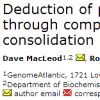 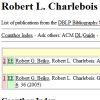  
Dave MacLeod,
Robert L. Charlebois,
W. Ford Doolittle and
Eric Bapteste. Deduction of probable events of lateral gene transfer through comparison of phylogenetic trees by recursive consolidation and rearrangement. In BMCEB, Vol. 5(27), 2005.
Keywords: explicit network, from rooted trees, lateral gene transfer, phylogenetic network, phylogeny, Program HorizStory, reconstruction, software.
Note: http://dx.doi.org/10.1186/1471-2148-5-27.
Toggle abstract
"Background: When organismal phylogenies based on sequences of single marker genes are poorly resolved, a logical approach is to add more markers, on the assumption that weak but congruent phylogenetic signal will be reinforced in such multigene trees. Such approaches are valid only when the several markers indeed have identical phylogenies, an issue which many multigene methods (such as the use of concatenated gene sequences or the assembly of supertrees) do not directly address. Indeed, even when the true history is a mixture of vertical descent for some genes and lateral gene transfer (LGT) for others, such methods produce unique topologies. Results: We have developed software that aims to extract evidence for vertical and lateral inheritance from a set of gene trees compared against an arbitrary reference tree. This evidence is then displayed as a synthesis showing support over the tree for vertical inheritance, overlaid with explicit lateral gene transfer (LGT) events inferred to have occurred over the history of the tree. Like splits-tree methods, one can thus identify nodes at which conflict occurs. Additionally one can make reasonable inferences about vertical and lateral signal, assigning putative donors and recipients. Conclusion: A tool such as ours can serve to explore the reticulated dimensionality of molecular evolution, by dissecting vertical and lateral inheritance at high resolution. By this, we mean that individual nodes can be examined not only for congruence, but also for coherence in light of LGT. We assert that our tools will facilitate the comparison of phylogenetic trees, and the interpretation of conflicting data. © 2005 MacLeod et al; licensee BioMed Central Ltd."
|
|
| |
 
Robert G. Beiko and
Nicholas Hamilton. Phylogenetic identification of lateral genetic transfer events. In BMCEB, Vol. 6(15), 2006.
Keywords: evaluation, from rooted trees, from unrooted trees, lateral gene transfer, Program EEEP, Program HorizStory, Program LatTrans, reconstruction, software, SPR distance.
Note: http://dx.doi.org/10.1186/1471-2148-6-15.
Toggle abstract
"Background: Lateral genetic transfer can lead to disagreements among phylogenetic trees comprising sequences from the same set of taxa. Where topological discordance is thought to have arisen through genetic transfer events, tree comparisons can be used to identify the lineages that may have shared genetic information. An 'edit path' of one or more transfer events can be represented with a series of subtree prune and regraft (SPR) operations, but finding the optimal such set of operations is NP-hard for comparisons between rooted trees, and may be so for unrooted trees as well. Results: Efficient Evaluation of Edit Paths (EEEP) is a new tree comparison algorithm that uses evolutionarily reasonable constraints to identify and eliminate many unproductive search avenues, reducing the time required to solve many edit path problems. The performance of EEEP compares favourably to that of other algorithms when applied to strictly bifurcating trees with specified numbers of SPR operations. We also used EEEP to recover edit paths from over 19 000 unrooted, incompletely resolved protein trees containing up to 144 taxa as part of a large phylogenomic study. While inferred protein trees were far more similar to a reference supertree than random trees were to each other, the phylogenetic distance spanned by random versus inferred transfer events was similar, suggesting that real transfer events occur most frequently between closely related organisms, but can span large phylogenetic distances as well. While most of the protein trees examined here were very similar to the reference supertree, requiring zero or one edit operations for reconciliation, some trees implied up to 40 transfer events within a single orthologous set of proteins. Conclusion: Since sequence trees typically have no implied root and may contain unresolved or multifurcating nodes, the strategy implemented in EEEP is the most appropriate for phylogenomic analyses. The high degree of consistency among inferred protein trees shows that vertical inheritance is the dominant pattern of evolution, at least for the set of organisms considered here. However, the edit paths inferred using EEEP suggest an important role for genetic transfer in the evolution of microbial genomes as well. © 2006Beiko and Hamilton; licensee BioMed Central Ltd."
|
|
| |
    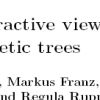 
Daniel H. Huson,
Daniel C. Richter,
Christian Rausch,
Tobias Dezulian,
Markus Franz and
Regula Rupp. Dendroscope: An interactive viewer for large phylogenetic trees. In BMCB, Vol. 8:460, 2007.
Keywords: phylogeny, Program Dendroscope, software, visualization.
Note: http://dx.doi.org/10.1186/1471-2105-8-460, slides available at http://www.newton.cam.ac.uk/webseminars/pg+ws/2007/plg/plgw01/0903/huson/, software freely available from http://www.dendroscope.org.
Toggle abstract
"Background: Research in evolution requires software for visualizing and editing phylogenetic trees, for increasingly very large datasets, such as arise in expression analysis or metagenomics, for example. It would be desirable to have a program that provides these services in an effcient and user-friendly way, and that can be easily installed and run on all major operating systems. Although a large number of tree visualization tools are freely available, some as a part of more comprehensive analysis packages, all have drawbacks in one or more domains. They either lack some of the standard tree visualization techniques or basic graphics and editing features, or they are restricted to small trees containing only tens of thousands of taxa. Moreover, many programs are diffcult to install or are not available for all common operating systems. Results: We have developed a new program, Dendroscope, for the interactive visualization and navigation of phylogenetic trees. The program provides all standard tree visualizations and is optimized to run interactively on trees containing hundreds of thousands of taxa. The program provides tree editing and graphics export capabilities. To support the inspection of large trees, Dendroscope offers a magnification tool. The software is written in Java 1.4 and installers are provided for Linux/Unix, MacOS X and Windows XP. Conclusion: Dendroscope is a user-friendly program for visualizing and navigating phylogenetic trees, for both small and large datasets. © 2007 Huson et al; licensee BioMed Central Ltd."
|
|
| |
   
Dan Gusfield,
Vikas Bansal,
Vineet Bafna and
Yun S. Song. A Decomposition Theory for Phylogenetic Networks and Incompatible Characters. In JCB, Vol. 14(10):1247-1272, 2007.
Keywords: explicit network, from sequences, galled tree, phylogenetic network, phylogeny, Program Beagle, Program GalledTree, recombination, reconstruction, software.
Note: http://www.eecs.berkeley.edu/~yss/Pub/decomposition.pdf.
|
|
| |
 
Patricia Buendia and
Giri Narasimhan. Serial NetEvolve: A flexible utility for generating serially-sampled sequences along a tree or recombinant network. In BIO, Vol. 18(22):2313-2314, 2006.
Keywords: generation, phylogenetic network, phylogeny, Program Serial NetEvolve, Program Treevolve, recombination, software.
Note: http://dx.doi.org/10.1093/bioinformatics/btl387.
Toggle abstract
"Summary: Serial NetEvolve is a flexible simulation program that generates DNA sequences evolved along a tree or recombinant network. It offers a user-friendly Windows graphical interface and a Windows or Linux simulator with a diverse selection of parameters to control the evolutionary model. Serial NetEvolve is a modification of the Treevolve program with the following additional features: simulation of serially-sampled data, the choice of either a clock-like or a variable rate model of sequence evolution, sampling from the internal nodes and the output of the randomly generated tree or network in our newly proposed NeTwick format. © 2006 Oxford University Press."
|
|
| |
 
Patricia Buendia and
Giri Narasimhan. Sliding MinPD: Building evolutionary networks of serial samples via an automated recombination detection approach. In BIO, Vol. 23(22):2993-3000, 2007.
Keywords: from sequences, phylogenetic network, phylogeny, Program Sliding MinPD, recombination, recombination detection, serial evolutionary networks, software.
Note: http://dx.doi.org/10.1093/bioinformatics/btm413.
Toggle abstract
"Motivation: Traditional phylogenetic methods assume tree-like evolutionary models and are likely to perform poorly when provided with sequence data from fast-evolving, recombining viruses. Furthermore, these methods assume that all the sequence data are from contemporaneous taxa, which is not valid for serially-sampled data. A more general approach is proposed here, referred to as the Sliding MinPD method, that reconstructs evolutionary networks for serially-sampled sequences in the presence of recombination. Results: Sliding MinPD combines distance-based phylogenetic methods with automated recombination detection based on the best-known sliding window approaches to reconstruct serial evolutionary networks. Its performance was evaluated through comprehensive simulation studies and was also applied to a set of serially-sampled HIV sequences from a single patient. The resulting network organizations reveal unique patterns of viral evolution and may help explain the emergence of disease-associated mutants and drug-resistant strains with implications for patient prognosis and treatment strategies. © The Author 2007. Published by Oxford University Press. All rights reserved."
|
|
| |
  
Insa Cassens,
Patrick Mardulyn and
Michel C. Milinkovitch. Evaluating Intraspecific Network Construction Methods Using Simulated Sequence Data: Do Existing Algorithms Outperform the Global Maximum Parsimony Approach? In Systematic Biology, Vol. 54(3):363-372, 2005.
Keywords: abstract network, evaluation, from unrooted trees, haplotype network, parsimony, phylogenetic network, phylogeny, Program Arlequin, Program CombineTrees, Program Network, Program TCS, reconstruction, software.
Note: http://www.lanevol.org/LANE/publications_files/Cassens_etal_SystBio_2005.pdf.
|
|
| |
|
| |
 
Tobias Kloepper and
Daniel H. Huson. Drawing explicit phylogenetic networks and their integration into SplitsTree. In BMCEB, Vol. 8(22), 2008.
Keywords: explicit network, phylogenetic network, phylogeny, Program SplitsTree, software, split network, visualization.
Note: http://dx.doi.org/10.1186/1471-2148-8-22.
Toggle abstract
"Background. SplitsTree provides a framework for the calculation of phylogenetic trees and networks. It contains a wide variety of methods for the import/export, calculation and visualization of phylogenetic information. The software is developed in Java and implements a command line tool as well as a graphical user interface. Results. In this article, we present solutions to two important problems in the field of phylogenetic networks. The first problem is the visualization of explicit phylogenetic networks. To solve this, we present a modified version of the equal angle algorithm that naturally integrates reticulations into the layout process and thus leads to an appealing visualization of these networks. The second problem is the availability of explicit phylogenetic network methods for the general user. To advance the usage of explicit phylogenetic networks by biologists further, we present an extension to the SplitsTree framework that integrates these networks. By addressing these two problems, SplitsTree is among the first programs that incorporates implicit and explicit network methods together with standard phylogenetic tree methods in a graphical user interface environment. Conclusion. In this article, we presented an extension of SplitsTree 4 that incorporates explicit phylogenetic networks. The extension provides a set of core classes to handle explicit phylogenetic networks and a visualization of these networks. © 2008 Kloepper and Huson; licensee BioMed Central Ltd."
|
|
| |
  
Cuong Than,
Derek Ruths and
Luay Nakhleh. PhyloNet: A Software Package for Analyzing and Reconstructing Reticulate Evolutionary Relationships. In BMCB, Vol. 9(322), 2008.
Keywords: Program PhyloNet, software.
Note: http://dx.doi.org/10.1186/1471-2105-9-322.
Toggle abstract
"Background: Phylogenies, i.e., the evolutionary histories of groups of taxa, play a major role in representing the interrelationships among biological entities. Many software tools for reconstructing and evaluating such phylogenies have been proposed, almost all of which assume the underlying evolutionary history to be a tree. While trees give a satisfactory first-order approximation for many families of organisms, other families exhibit evolutionary mechanisms that cannot be represented by trees. Processes such as horizontal gene transfer (HGT), hybrid speciation, and interspecific recombination, collectively referred to as reticulate evolutionary events, result in networks, rather than trees, of relationships. Various software tools have been recently developed to analyze reticulate evolutionary relationships, which include SplitsTree4, LatTrans, EEEP, HorizStory, and T-REX. Results: In this paper, we report on the PhyloNet software package, which is a suite of tools for analyzing reticulate evolutionary relationships, or evolutionary networks, which are rooted, directed, acyclic graphs, leaf-labeled by a set of taxa. These tools can be classified into four categories: (1) evolutionary network representation: reading/writing evolutionary networks in a newly devised compact form; (2) evolutionary network characterization: analyzing evolutionary networks in terms of three basic building blocks - trees, clusters, and tripartitions; (3) evolutionary network comparison: comparing two evolutionary networks in terms of topological dissimilarities, as well as fitness to sequence evolution under a maximum parsimony criterion; and (4) evolutionary network reconstruction: reconstructing an evolutionary network from a species tree and a set of gene trees. Conclusion: The software package, PhyloNet, offers an array of utilities to allow for efficient and accurate analysis of evolutionary networks. The software package will help significantly in analyzing large data sets, as well as in studying the performance of evolutionary network reconstruction methods. Further, the software package supports the proposed eNewick format for compact representation of evolutionary networks, a feature that allows for efficient interoperability of evolutionary network software tools. Currently, all utilities in PhyloNet are invoked on the command line. © 2008 Than et al; licensee BioMed Central Ltd."
|
|
| |
|
| |
 
Supriya Munshaw and
Thomas B. Kepler. An Information-Theoretic Method for the Treatment of Plural Ancestry in Phylogenetics. In MBE, Vol. 25(6):1199-1208, 2008.
Keywords: explicit network, from sequences, heuristic, phylogenetic network, reconstruction, simulated annealing, software.
Note: http://dx.doi.org/10.1093/molbev/msn066.
Toggle abstract
"In the presence of recombination and gene conversion, a given genomic segment may inherit information from 2 distinct immediate ancestors. The importance of this type of molecular inheritance has become increasingly clear over the years, and the potential for erroneous inference when it is not accounted for in the statistical model is well documented. Yet, the inclusion of plural ancestry (PA) in phylogenetic analysis is still not routine. This omission is due to the greater difficulty of phylogenetic inference on general acyclic graphs compared that on with trees and the accompanying computational burden. We have developed a technique for phylogenetic inference in the presence of PA based on the principle of minimum description length, which assigns a cost - the description length - to each network topology given the observed sequence data. The description length combines the cost of poor data fit and model complexity in terms of information. This device allows us to search through network topologies to minimize the total description length. By comparing the best models obtained with and without PA, one can determine whether or not recombination has played an active role in the evolution of the genes under investigation, identify those genes that appear to be mosaic, and infer the phylogenetic network that best represents the history of the alignment. We show that the method performs well on simulated data and demonstrate its application on HIV env gene sequence data from 8 human subjects. The software implementation of the method is available upon request. © The Author 2008. Published by Oxford University Press on behalf of the Society for Molecular Biology and Evolution. All rights reserved."
|
|
| |
 
Miguel Arenas and
David Posada. Recodon: Coalescent simulation of coding DNA sequences with recombination, migration and demography. In BMCB, Vol. 8(458), 2008.
Keywords: coalescent, generation, Program Recodon, software.
Note: http://dx.doi.org/10.1186/1471-2105-8-458.
Toggle abstract
"Background: Coalescent simulations have proven very useful in many population genetics studies. In order to arrive to meaningful conclusions, it is important that these simulations resemble the process of molecular evolution as much as possible. To date, no single coalescent program is able to simulate codon sequences sampled from populations with recombination, migration and growth. Results: We introduce a new coalescent program, called Recodon, which is able to simulate samples of coding DNA sequences under complex scenarios in which several evolutionary forces can interact simultaneously (namely, recombination, migration and demography). The basic codon model implemented is an extension to the general time-reversible model of nucleotide substitution with a proportion of invariable sites and among-site rate variation. In addition, the program implements non-reversible processes and mixtures of different codon models. Conclusion: Recodon is a flexible tool for the simulation of coding DNA sequences under realistic evolutionary models. These simulations can be used to build parameter distributions for testing evolutionary hypotheses using experimental data. Recodon is written in C, can run in parallel, and is freely available from http://darwin.uvigo.es/. © 2007 Arenas and Posada; licensee BioMed Central Ltd."
|
|
| |
   
Martin Lott,
Andreas Spillner,
Katharina Huber and
Vincent Moulton. PADRE: A Package for Analyzing and Displaying Reticulate Evolution. In BIO, Vol. 25(9):1199-1200, 2009.
Keywords: duplication, explicit network, from multilabeled tree, phylogenetic network, phylogeny, Program PADRE, reconstruction, software.
Note: http://dx.doi.org/10.1093/bioinformatics/btp133.
Toggle abstract
"Recent advances in gene sequencing for polyploid species, coupled with standard phylogenetic tree reconstruction, leads to gene trees in which the same species can label several leaves. Such multi-labeled trees are then used to reconstruct the evolutionary history of the polyploid species in question. However, this reconstruction process requires new techniques that are not available in current phylogenetic software packages. Here, we describe the software package PADRE (Package for Analyzing and Displaying Reticulate Evolution) that implements such techniques, allowing the reconstruction of complex evolutionary histories for polyploids in the form of phylogenetic networks. © The Author 2009. Published by Oxford University Press. All rights reserved."
|
|
| |
   
Katharina Huber,
Leo van Iersel,
Steven Kelk and
Radoslaw Suchecki. A Practical Algorithm for Reconstructing Level-1 Phylogenetic Networks. In TCBB, Vol. 8(3):607-620, 2011.
Keywords: explicit network, from triplets, galled tree, generation, heuristic, phylogenetic network, phylogeny, Program LEV1ATHAN, Program Lev1Generator, reconstruction, software.
Note: http://arxiv.org/abs/0910.4067.
Toggle abstract
"Recently, much attention has been devoted to the construction of phylogenetic networks which generalize phylogenetic trees in order to accommodate complex evolutionary processes. Here, we present an efficient, practical algorithm for reconstructing level-1 phylogenetic networks-a type of network slightly more general than a phylogenetic tree-from triplets. Our algorithm has been made publicly available as the program Lev1athan. It combines ideas from several known theoretical algorithms for phylogenetic tree and network reconstruction with two novel subroutines. Namely, an exponential-time exact and a greedy algorithm both of which are of independent theoretical interest. Most importantly, Lev1athan runs in polynomial time and always constructs a level-1 network. If the data are consistent with a phylogenetic tree, then the algorithm constructs such a tree. Moreover, if the input triplet set is dense and, in addition, is fully consistent with some level-1 network, it will find such a network. The potential of Lev1athan is explored by means of an extensive simulation study and a biological data set. One of our conclusions is that Lev1athan is able to construct networks consistent with a high percentage of input triplets, even when these input triplets are affected by a low to moderate level of noise. © 2011 IEEE."
|
|
| |
  
Josh Voorkamp né Collins,
Simone Linz and
Charles Semple. Quantifying hybridization in realistic time. In JCB, Vol. 18(10):1305-1318, 2011.
Keywords: explicit network, FPT, from rooted trees, hybridization, minimum number, phylogenetic network, phylogeny, Program HybridInterleave, reconstruction, software.
Note: http://wwwcsif.cs.ucdavis.edu/~linzs/CLS10_interleave.pdf, software available at http://www.math.canterbury.ac.nz/~c.semple/software.shtml.
Toggle abstract
"Recently, numerous practical and theoretical studies in evolutionary biology aim at calculating the extent to which reticulation-for example, horizontal gene transfer, hybridization, or recombination-has influenced the evolution for a set of present-day species. It has been shown that inferring the minimum number of hybridization events that is needed to simultaneously explain the evolutionary history for a set of trees is an NP-hard and also fixed-parameter tractable problem. In this article, we give a new fixed-parameter algorithm for computing the minimum number of hybridization events for when two rooted binary phylogenetic trees are given. This newly developed algorithm is based on interleaving-a technique using repeated kernelization steps that are applied throughout the exhaustive search part of a fixed-parameter algorithm. To show that our algorithm runs efficiently to be applicable to a wide range of practical problem instances, we apply it to a grass data set and highlight the significant improvements in terms of running times in comparison to an algorithm that has previously been implemented. © 2011, Mary Ann Liebert, Inc."
|
|
| |
   
Miguel Arenas,
Mateus Patricio,
David Posada and
Gabriel Valiente. Characterization of Phylogenetic Networks with NetTest. In BMCB, Vol. 11:268, 2010.
Keywords: explicit network, galled tree, phylogenetic network, Program NetTest, software, time consistent network, tree sibling network, tree-child network, visualization.
Note: http://dx.doi.org/10.1186/1471-2105-11-268, software available at http://darwin.uvigo.es/software/nettest/.
Toggle abstract
"Background: Typical evolutionary events like recombination, hybridization or gene transfer make necessary the use of phylogenetic networks to properly depict the evolution of DNA and protein sequences. Although several theoretical classes have been proposed to characterize these networks, they make stringent assumptions that will likely not be met by the evolutionary process. We have recently shown that the complexity of simulated networks is a function of the population recombination rate, and that at moderate and large recombination rates the resulting networks cannot be categorized. However, we do not know whether these results extend to networks estimated from real data.Results: We introduce a web server for the categorization of explicit phylogenetic networks, including the most relevant theoretical classes developed so far. Using this tool, we analyzed statistical parsimony phylogenetic networks estimated from ~5,000 DNA alignments, obtained from the NCBI PopSet and Polymorphix databases. The level of characterization was correlated to nucleotide diversity, and a high proportion of the networks derived from these data sets could be formally characterized.Conclusions: We have developed a public web server, NetTest (freely available from the software section at http://darwin.uvigo.es), to formally characterize the complexity of phylogenetic networks. Using NetTest we found that most statistical parsimony networks estimated with the program TCS could be assigned to a known network class. The level of network characterization was correlated to nucleotide diversity and dependent upon the intra/interspecific levels, although no significant differences were detected among genes. More research on the properties of phylogenetic networks is clearly needed. © 2010 Arenas et al; licensee BioMed Central Ltd."
|
|
| |
   
Sophie Abby,
Eric Tannier,
Manolo Gouy and
Vincent Daubin. Detecting lateral gene transfers by statistical reconciliation of phylogenetic forests. In BMCB, Vol. 11:324, 2010.
Keywords: agreement forest, explicit network, from rooted trees, from species tree, heuristic, lateral gene transfer, phylogenetic network, phylogeny, Program EEEP, Program PhyloNet, Program Prunier, reconstruction, software.
Note: http://www.biomedcentral.com/1471-2105/11/324.
Toggle abstract
"Background: To understand the evolutionary role of Lateral Gene Transfer (LGT), accurate methods are needed to identify transferred genes and infer their timing of acquisition. Phylogenetic methods are particularly promising for this purpose, but the reconciliation of a gene tree with a reference (species) tree is computationally hard. In addition, the application of these methods to real data raises the problem of sorting out real and artifactual phylogenetic conflict.Results: We present Prunier, a new method for phylogenetic detection of LGT based on the search for a maximum statistical agreement forest (MSAF) between a gene tree and a reference tree. The program is flexible as it can use any definition of "agreement" among trees. We evaluate the performance of Prunier and two other programs (EEEP and RIATA-HGT) for their ability to detect transferred genes in realistic simulations where gene trees are reconstructed from sequences. Prunier proposes a single scenario that compares to the other methods in terms of sensitivity, but shows higher specificity. We show that LGT scenarios carry a strong signal about the position of the root of the species tree and could be used to identify the direction of evolutionary time on the species tree. We use Prunier on a biological dataset of 23 universal proteins and discuss their suitability for inferring the tree of life.Conclusions: The ability of Prunier to take into account branch support in the process of reconciliation allows a gain in complexity, in comparison to EEEP, and in accuracy in comparison to RIATA-HGT. Prunier's greedy algorithm proposes a single scenario of LGT for a gene family, but its quality always compares to the best solutions provided by the other algorithms. When the root position is uncertain in the species tree, Prunier is able to infer a scenario per root at a limited additional computational cost and can easily run on large datasets.Prunier is implemented in C++, using the Bio++ library and the phylogeny program Treefinder. It is available at: http://pbil.univ-lyon1.fr/software/prunier. © 2010 Abby et al; licensee BioMed Central Ltd."
|
|
| |

Nicolas Galtier. A model of horizontal gene transfer and the bacterial phylogeny problem. In Systematic Biology, Vol. 56(4):633-642, 2007.
Keywords: explicit network, generation, lateral gene transfer, phylogenetic network, phylogeny, Program HGT_simul, software, statistical model.
Note: http://dx.doi.org/10.1080/10635150701546231.
Toggle abstract
"How much horizontal gene transfer (HGT) between species influences bacterial phylogenomics is a controversial issue. This debate, however, lacks any quantitative assessment of the impact of HGT on phylogenies and of the ability of tree-building methods to cope with such events. I introduce a Markov model of genome evolution with HGT, accounting for the constraints on time-an HGT event can only occur between concomitantly living species. This model is used to simulate multigene sequence data sets with or without HGT. The consequences of HGT on phylogenomic inference are analyzed and compared to other well-known phylogenetic artefacts. It is found that supertree methods are quite robust to HGT, keeping high levels of performance even when gene trees are largely incongruent with each other. Gene tree incongruence per se is not indicative of HGT. HGT, however, removes the (otherwise observed) positive relationship between sequence length and gene tree congruence to the estimated species tree. Surprisingly, when applied to a bacterial and a eukaryotic multigene data set, this criterion rejects the HGT hypothesis for the former, but not the latter data set. Copyright © Society of Systematic Biologists."
|
|
| |
  
Changiz Eslahchi,
Mahnaz Habibi,
Reza Hassanzadeh and
Ehsan Mottaghi. MC-Net: a method for the construction of phylogenetic networks based on the Monte-Carlo method. In BMCEB, Vol. 10:254, 2010.
Keywords: abstract network, circular split system, from distances, heuristic, phylogenetic network, Program MC-Net, Program SplitsTree, software, split, split network.
Note: http://dx.doi.org/10.1186/1471-2148-10-254.
Toggle abstract
"Background. A phylogenetic network is a generalization of phylogenetic trees that allows the representation of conflicting signals or alternative evolutionary histories in a single diagram. There are several methods for constructing these networks. Some of these methods are based on distances among taxa. In practice, the methods which are based on distance perform faster in comparison with other methods. The Neighbor-Net (N-Net) is a distance-based method. The N-Net produces a circular ordering from a distance matrix, then constructs a collection of weighted splits using circular ordering. The SplitsTree which is a program using these weighted splits makes a phylogenetic network. In general, finding an optimal circular ordering is an NP-hard problem. The N-Net is a heuristic algorithm to find the optimal circular ordering which is based on neighbor-joining algorithm. Results. In this paper, we present a heuristic algorithm to find an optimal circular ordering based on the Monte-Carlo method, called MC-Net algorithm. In order to show that MC-Net performs better than N-Net, we apply both algorithms on different data sets. Then we draw phylogenetic networks corresponding to outputs of these algorithms using SplitsTree and compare the results. Conclusions. We find that the circular ordering produced by the MC-Net is closer to optimal circular ordering than the N-Net. Furthermore, the networks corresponding to outputs of MC-Net made by SplitsTree are simpler than N-Net. © 2010 Eslahchi et al; licensee BioMed Central Ltd."
|
|
| |
 
Zhi-Zhong Chen and
Lusheng Wang. HybridNET: a tool for constructing hybridization networks. In BIO, Vol. 26(22):2912-2913, 2010.
Keywords: agreement forest, FPT, from rooted trees, hybridization, phylogenetic network, phylogeny, Program HybridNET, software.
Note: http://rnc.r.dendai.ac.jp/~chen/papers/note2.pdf.
Toggle abstract
"Motivations: When reticulation events occur, the evolutionary history of a set of existing species can be represented by a hybridization network instead of an evolutionary tree. When studying the evolutionary history of a set of existing species, one can obtain a phylogenetic tree of the set of species with high confidence by looking at a segment of sequences or a set of genes. When looking at another segment of sequences, a different phylogenetic tree can be obtained with high confidence too. This indicates that reticulation events may occur. Thus, we have the following problem: given two rooted phylogenetic trees on a set of species that correctly represent the tree-like evolution of different parts of their genomes, what is the hybridization network with the smallest number of reticulation events to explain the evolution of the set of species under consideration? Results: We develop a program, named HybridNet, for constructing a hybridization network with the minimum number of reticulate vertices from two input trees. We first implement the O(3dn)-time algorithm by Whidden et al. for computing a maximum (acyclic) agreement forest. Our program can output all the maximum (acyclic) agreement forests. We then augment the program so that it can construct an optimal hybridization network for each given maximum acyclic agreement forest. To our knowledge, this is the first time that optimal hybridization networks can be rapidly constructed. © The Author 2010. Published by Oxford University Press. All rights reserved."
|
|
| |

Klaus Schliep. Phangorn: Phylogenetic analysis in R. In Bioinformatics, Vol. 27(4):592-593, 2011.
Keywords: abstract network, from distances, phylogenetic network, Program Phangorn, software, split, split network.
Note: http://dx.doi.org/10.1093/bioinformatics/btq706.
Toggle abstract
"Summary: phangorn is a package for phylogenetic reconstruction and analysis in the R language. Previously it was only possible to estimate phylogenetic trees with distance methods in R. phangorn, now offers the possibility of reconstructing phylogenies with distance based methods, maximum parsimony or maximum likelihood (ML) and performing Hadamard conjugation. Extending the general ML framework, this package provides the possibility of estimating mixture and partition models. Furthermore, phangorn offers several functions for comparing trees, phylogenetic models or splits, simulating character data and performing congruence analyses. © The Author(s) 2010. Published by Oxford University Press."
|
|
| |
  
Steven Kelk,
Celine Scornavacca and
Leo van Iersel. On the elusiveness of clusters. In TCBB, Vol. 9(2):517-534, 2012.
Keywords: explicit network, from clusters, from rooted trees, from triplets, level k phylogenetic network, phylogenetic network, phylogeny, Program Clustistic, reconstruction, software.
Note: http://arxiv.org/abs/1103.1834.
|
|
| |
 
Paul Phipps and
Sergey Bereg. Optimizing Phylogenetic Networks for Circular Split Systems. In TCBB, Vol. 9(2):535-547, 2012.
Keywords: abstract network, from distances, from splits, phylogenetic network, phylogeny, Program PhippsNetwork, reconstruction, software.
Toggle abstract
"We address the problem of realizing a given distance matrix by a planar phylogenetic network with a minimum number of faces. With the help of the popular software SplitsTree4, we start by approximating the distance matrix with a distance metric that is a linear combination of circular splits. The main results of this paper are the necessary and sufficient conditions for the existence of a network with a single face. We show how such a network can be constructed, and we present a heuristic for constructing a network with few faces using the first algorithm as the base case. Experimental results on biological data show that this heuristic algorithm can produce phylogenetic networks with far fewer faces than the ones computed by SplitsTree4, without affecting the approximation of the distance matrix. © 2012 IEEE."
|
|
| |
 
Zhi-Zhong Chen and
Lusheng Wang. Algorithms for Reticulate Networks of Multiple Phylogenetic Trees. In TCBB, Vol. 9(2):372-384, 2012.
Keywords: explicit network, from rooted trees, minimum number, phylogenetic network, phylogeny, Program CMPT, Program MaafB, reconstruction, software.
Note: http://rnc.r.dendai.ac.jp/~chen/papers/rMaaf.pdf.
Toggle abstract
"A reticulate network N of multiple phylogenetic trees may have nodes with two or more parents (called reticulation nodes). There are two ways to define the reticulation number of N. One way is to define it as the number of reticulation nodes in N in this case, a reticulate network with the smallest reticulation number is called an optimal type-I reticulate network of the trees. The better way is to define it as the total number of parents of reticulation nodes in N minus the number of reticulation nodes in N ; in this case, a reticulate network with the smallest reticulation number is called an optimal type-II reticulate network of the trees. In this paper, we first present a fast fixed-parameter algorithm for constructing one or all optimal type-I reticulate networks of multiple phylogenetic trees. We then use the algorithm together with other ideas to obtain an algorithm for estimating a lower bound on the reticulation number of an optimal type-II reticulate network of the input trees. To our knowledge, these are the first fixed-parameter algorithms for the problems. We have implemented the algorithms in ANSI C, obtaining programs CMPT and MaafB. Our experimental data show that CMPT can construct optimal type-I reticulate networks rapidly and MaafB can compute better lower bounds for optimal type-II reticulate networks within shorter time than the previously best program PIRN designed by Wu. © 2006 IEEE."
|
|
| |
    
Changiz Eslahchi,
Reza Hassanzadeh,
Ehsan Mottaghi,
Mahnaz Habibi,
Hamid Pezeshk and
Mehdi Sadeghi. Constructing circular phylogenetic networks from weighted quartets using simulated annealing. In MBIO, Vol. 235(2):123-127, 2012.
Keywords: abstract network, from quartets, heuristic, phylogenetic network, phylogeny, Program SAQ-Net, Program SplitsTree, reconstruction, simulated annealing, software, split network.
Note: http://dx.doi.org/10.1016/j.mbs.2011.11.003.
Toggle abstract
"In this paper, we present a heuristic algorithm based on the simulated annealing, SAQ-Net, as a method for constructing phylogenetic networks from weighted quartets. Similar to QNet algorithm, SAQ-Net constructs a collection of circular weighted splits of the taxa set. This collection is represented by a split network. In order to show that SAQ-Net performs better than QNet, we apply these algorithm to both the simulated and actual data sets containing salmonella, Bees, Primates and Rubber data sets. Then we draw phylogenetic networks corresponding to outputs of these algorithms using SplitsTree4 and compare the results. We find that SAQ-Net produces a better circular ordering and phylogenetic networks than QNet in most cases. SAQ-Net has been implemented in Matlab and is available for download at http://bioinf.cs.ipm.ac.ir/softwares/saq.net. © 2011 Elsevier Inc."
|
|
| |
  
Reza Hassanzadeh,
Changiz Eslahchi and
Wing-Kin Sung. Constructing phylogenetic supernetworks based on simulated annealing. In MPE, Vol. 63(3):738-744, 2012.
Keywords: abstract network, from unrooted trees, heuristic, phylogenetic network, phylogeny, Program SNSA, reconstruction, simulated annealing, software, split network.
Note: http://dx.doi.org/10.1016/j.ympev.2012.02.009.
Toggle abstract
Different partial phylogenetic trees can be derived from different sources of evidence and different methods. One important problem is to summarize these partial phylogenetic trees using a supernetwork. We propose a novel simulated annealing based method called SNSA which uses an optimization function to produce a simple network that still retains a great deal of phylogenetic information. We report the performance of this new method on real and simulated datasets. © 2012 Elsevier Inc.
|
|
| |
  
Hadi Poormohammadi,
Changiz Eslahchi and
Ruzbeh Tusserkani. TripNet: A Method for Constructing Rooted Phylogenetic Networks from Rooted Triplets. In PLoS ONE, Vol. 9(9):e106531, 2014.
Keywords: explicit network, from triplets, heuristic, level k phylogenetic network, phylogenetic network, phylogeny, Program TripNet, reconstruction, software.
Note: http://arxiv.org/abs/1201.3722.
Toggle abstract
"The problem of constructing an optimal rooted phylogenetic network from an arbitrary set of rooted triplets is an NP-hard problem. In this paper, we present a heuristic algorithm called TripNet, which tries to construct a rooted phylogenetic network with the minimum number of reticulation nodes from an arbitrary set of rooted triplets. Despite of current methods that work for dense set of rooted triplets, a key innovation is the applicability of TripNet to non-dense set of rooted triplets. We prove some theorems to clarify the performance of the algorithm. To demonstrate the efficiency of TripNet, we compared TripNet with SIMPLISTIC. It is the only available software which has the ability to return some rooted phylogenetic network consistent with a given dense set of rooted triplets. But the results show that for complex networks with high levels, the SIMPLISTIC running time increased abruptly. However in all cases TripNet outputs an appropriate rooted phylogenetic network in an acceptable time. Also we tetsed TripNet on the Yeast data. The results show that Both TripNet and optimal networks have the same clustering and TripNet produced a level-3 network which contains only one more reticulation node than the optimal network."
|
|
| |
    
Stefan Grünewald,
Andreas Spillner,
Sarah Bastkowski,
Anja Bögershausen and
Vincent Moulton. SuperQ: Computing Supernetworks from Quartets. In TCBB, Vol. 10(1):151-160, 2013.
Keywords: abstract network, circular split system, from quartets, heuristic, phylogenetic network, phylogeny, Program QNet, Program SplitsTree, Program SuperQ, software, split network.
Toggle abstract
"Supertrees are a commonly used tool in phylogenetics to summarize collections of partial phylogenetic trees. As a generalization of supertrees, phylogenetic supernetworks allow, in addition, the visual representation of conflict between the trees that is not possible to observe with a single tree. Here, we introduce SuperQ, a new method for constructing such supernetworks (SuperQ is freely available at >www.uea.ac.uk/computing/superq.). It works by first breaking the input trees into quartet trees, and then stitching these together to form a special kind of phylogenetic network, called a split network. This stitching process is performed using an adaptation of the QNet method for split network reconstruction employing a novel approach to use the branch lengths from the input trees to estimate the branch lengths in the resulting network. Compared with previous supernetwork methods, SuperQ has the advantage of producing a planar network. We compare the performance of SuperQ to the Z-closure and Q-imputation supernetwork methods, and also present an analysis of some published data sets as an illustration of its applicability. © 2004-2012 IEEE."
|
|
| |
  
Alix Boc,
Alpha B. Diallo and
Vladimir Makarenkov. T-REX: a web server for inferring, validating and visualizing phylogenetic trees and networks. In NAR, Vol. 40(W1):W573-W579, 2012.
Keywords: from rooted trees, from species tree, lateral gene transfer, phylogenetic network, phylogeny, Program T REX, reconstruction, reticulogram, software.
Note: http://dx.doi.org/10.1093/nar/gks485.
Toggle abstract
"T-REX (Tree and reticulogram REConstruction) is a web server dedicated to the reconstruction of phylogenetic trees, reticulation networks and to the inference of horizontal gene transfer (HGT) events. T-REX includes several popular bioinformatics applications such as MUSCLE, MAFFT, Neighbor Joining, NINJA, BioNJ, PhyML, RAxML, random phylogenetic tree generator and some well-known sequence-to-distance transformation models. It also comprises fast and effective methods for inferring phylogenetic trees from complete and incomplete distance matrices as well as for reconstructing reticulograms and HGT networks, including the detection and validation of complete and partial gene transfers, inference of consensus HGT scenarios and interactive HGT identification, developed by the authors. The included methods allows for validating and visualizing phylogenetic trees and networks which can be built from distance or sequence data. The web server is available at: www.trex.uqam.ca. © 2012 The Author(s)."
|
|
| |
 
Daniel H. Huson and
Celine Scornavacca. Dendroscope 3: An Interactive Tool for Rooted Phylogenetic Trees and Networks. In Systematic Biology, Vol. 61(6):1061-1067, 2012.
Keywords: from rooted trees, from triplets, phylogenetic network, phylogeny, Program Dendroscope, reconstruction, software, visualization.
Toggle abstract
"Dendroscope 3 is a new program for working with rooted phylogenetic trees and networks. It provides a number of methods for drawing and comparing rooted phylogenetic networks, and for computing them from rooted trees. The program can be used interactively or in command-line mode. The program is written in Java, use of the software is free, and installers for all 3 major operating systems can be downloaded from www.dendroscope.org. [Phylogenetic trees; phylogenetic networks; software.] © 2012 The Author(s)."
|
|
| |
 
Zhi-Zhong Chen,
Lusheng Wang and
Satoshi Yamanaka. A fast tool for minimum hybridization networks. In BMCB, Vol. 13:155, 2012.
Keywords: agreement forest, explicit network, from rooted trees, phylogenetic network, phylogeny, Program FastHN, reconstruction, software.
Note: http://dx.doi.org/10.1186/1471-2105-13-155.
Toggle abstract
"Background: Due to hybridization events in evolution, studying two different genes of a set of species may yield two related but different phylogenetic trees for the set of species. In this case, we want to combine the two phylogenetic trees into a hybridization network with the fewest hybridization events. This leads to three computational problems, namely, the problem of computing the minimum size of a hybridization network, the problem of constructing one minimum hybridization network, and the problem of enumerating a representative set of minimum hybridization networks. The previously best software tools for these problems (namely, Chen and Wang's HybridNet and Albrecht et al.'s Dendroscope 3) run very slowly for large instances that cannot be reduced to relatively small instances. Indeed, when the minimum size of a hybridization network of two given trees is larger than 23 and the problem for the trees cannot be reduced to relatively smaller independent subproblems, then HybridNet almost always takes longer than 1 day and Dendroscope 3 often fails to complete. Thus, a faster software tool for the problems is in need.Results: We develop a software tool in ANSI C, named FastHN, for the following problems: Computing the minimum size of a hybridization network, constructing one minimum hybridization network, and enumerating a representative set of minimum hybridization networks. We obtain FastHN by refining HybridNet with three ideas. The first idea is to preprocess the input trees so that the trees become smaller or the problem becomes to solve two or more relatively smaller independent subproblems. The second idea is to use a fast algorithm for computing the rSPR distance of two given phylognetic trees to cut more branches of the search tree in the exhaustive-search stage of the algorithm. The third idea is that during the exhaustive-search stage of the algorithm, we find two sibling leaves in one of the two forests (obtained from the given trees by cutting some edges) such that they are as far as possible in the other forest. As the result, FastHN always runs much faster than HybridNet. Unlike Dendroscope 3, FastHN is a single-threaded program. Despite this disadvantage, our experimental data shows that FastHN runs substantially faster than the multi-threaded Dendroscope 3 on a PC with multiple cores. Indeed, FastHN can finish within 16 minutes (on average on a Windows-7 (x64) desktop PC with i7-2600 CPU) even if the minimum size of a hybridization network of two given trees is about 25, the trees each have 100 leaves, and the problem for the input trees cannot be reduced to two or more independent subproblems via cluster reductions. It is also worth mentioning that like HybridNet, FastHN does not use much memory (indeed, the amount of memory is at most quadratic in the input size). In contrast, Dendroscope 3 uses a huge amount of memory. Executables of FastHN for Windows XP (x86), Windows 7 (x64), Linux, and Mac OS are available (see the Results and discussion section for details).Conclusions: For both biological datasets and simulated datasets, our experimental results show that FastHN runs substantially faster than HybridNet and Dendroscope 3. The superiority of FastHN in speed over the previous tools becomes more significant as the hybridization number becomes larger. In addition, FastHN uses much less memory than Dendroscope 3 and uses the same amount of memory as HybridNet. © 2012 Chen et al.; licensee BioMed Central Ltd."
|
|
| |
   
Mareike Fischer,
Leo van Iersel,
Steven Kelk and
Celine Scornavacca. On Computing The Maximum Parsimony Score Of A Phylogenetic Network. In SIDMA, Vol. 29(1):559-585, 2015.
Keywords: APX hard, cluster containment, explicit network, FPT, from network, from sequences, integer linear programming, level k phylogenetic network, NP complete, parsimony, phylogenetic network, phylogeny, polynomial, Program MPNet, reconstruction, software.
Note: http://arxiv.org/abs/1302.2430.
|
|
| |
  
Fenglou Mao,
David Williams,
Olga Zhaxybayeva,
Maria S. Poptsova,
Pascal Lapierre,
J. Peter Gogarten and
Ying Xu. Quartet decomposition server: a platform for analyzing phylogenetic trees. In BMCB, Vol. 13:123, 2012.
Keywords: abstract network, from quartets, phylogenetic network, phylogeny, Program Quartet Decomposition, reconstruction, software, split network.
Toggle abstract
"Background: The frequent exchange of genetic material among prokaryotes means that extracting a majority or plurality phylogenetic signal from many gene families, and the identification of gene families that are in significant conflict with the plurality signal is a frequent task in comparative genomics, and especially in phylogenomic analyses. Decomposition of gene trees into embedded quartets (unrooted trees each with four taxa) is a convenient and statistically powerful technique to address this challenging problem. This approach was shown to be useful in several studies of completely sequenced microbial genomes.Results: We present here a web server that takes a collection of gene phylogenies, decomposes them into quartets, generates a Quartet Spectrum, and draws a split network. Users are also provided with various data download options for further analyses. Each gene phylogeny is to be represented by an assessment of phylogenetic information content, such as sets of trees reconstructed from bootstrap replicates or sampled from a posterior distribution. The Quartet Decomposition server is accessible at http://quartets.uga.edu.Conclusions: The Quartet Decomposition server presented here provides a convenient means to perform Quartet Decomposition analyses and will empower users to find statistically supported phylogenetic conflicts. © 2012 Mao et al.; licensee BioMed Central Ltd."
|
|
| |
    
Thi-Hau Nguyen,
Vincent Ranwez,
Stéphanie Pointet,
Anne-Muriel Chifolleau Arigon,
Jean-Philippe Doyon and
Vincent Berry. Reconciliation and local gene tree rearrangement can be of mutual profit. In ALMOB, Vol. 8(12), 2013.
Keywords: duplication, explicit network, from rooted trees, heuristic, lateral gene transfer, phylogenetic network, phylogeny, Program Mowgli, Program MowgliNNI, Program Prunier, reconstruction, software.
Toggle abstract
"Background: Reconciliation methods compare gene trees and species trees to recover evolutionary events such as duplications, transfers and losses explaining the history and composition of genomes. It is well-known that gene trees inferred from molecular sequences can be partly erroneous due to incorrect sequence alignments as well as phylogenetic reconstruction artifacts such as long branch attraction. In practice, this leads reconciliation methods to overestimate the number of evolutionary events. Several methods have been proposed to circumvent this problem, by collapsing the unsupported edges and then resolving the obtained multifurcating nodes, or by directly rearranging the binary gene trees. Yet these methods have been defined for models of evolution accounting only for duplications and losses, i.e. can not be applied to handle prokaryotic gene families.Results: We propose a reconciliation method accounting for gene duplications, losses and horizontal transfers, that specifically takes into account the uncertainties in gene trees by rearranging their weakly supported edges. Rearrangements are performed on edges having a low confidence value, and are accepted whenever they improve the reconciliation cost. We prove useful properties on the dynamic programming matrix used to compute reconciliations, which allows to speed-up the tree space exploration when rearrangements are generated by Nearest Neighbor Interchanges (NNI) edit operations. Experiments on synthetic data show that gene trees modified by such NNI rearrangements are closer to the correct simulated trees and lead to better event predictions on average. Experiments on real data demonstrate that the proposed method leads to a decrease in the reconciliation cost and the number of inferred events. Finally on a dataset of 30 k gene families, this reconciliation method shows a ranking of prokaryotic phyla by transfer rates identical to that proposed by a different approach dedicated to transfer detection [BMCBIOINF 11:324, 2010, PNAS 109(13):4962-4967, 2012].Conclusions: Prokaryotic gene trees can now be reconciled with their species phylogeny while accounting for the uncertainty of the gene tree. More accurate and more precise reconciliations are obtained with respect to previous parsimony algorithms not accounting for such uncertainties [LNCS 6398:93-108, 2010, BIOINF 28(12): i283-i291, 2012].A software implementing the method is freely available at http://www.atgc-montpellier.fr/Mowgli/. © 2013 Nguyen et al.; licensee BioMed Central Ltd."
|
|
| |
    
Juan Wang,
Maozu Guo,
Xiaoyan Liu,
Yang Liu,
Chunyu Wang,
Linlin Xing and
Kai Che. LNETWORK: An Efficient and Effective Method for Constructing Phylogenetic Networks. In BIO, Vol. 29(18):2269-2276, 2013.
Keywords: explicit network, from rooted trees, phylogenetic network, phylogeny, Program LNetwork, reconstruction, software.
Toggle abstract
"Motivation: The evolutionary history of species is traditionally represented with a rooted phylogenetic tree. Each tree comprises a set of clusters, i.e. subsets of the species that are descended from a common ancestor. When rooted phylogenetic trees are built from several different datasets (e.g. from different genes), the clusters are often conflicting. These conflicting clusters cannot be expressed as a simple phylogenetic tree; however, they can be expressed in a phylogenetic network. Phylogenetic networks are a generalization of phylogenetic trees that can account for processes such as hybridization, horizontal gene transfer and recombination, which are difficult to represent in standard tree-like models of evolutionary histories. There is currently a large body of research aimed at developing appropriate methods for constructing phylogenetic networks from cluster sets. The Cass algorithm can construct a much simpler network than other available methods, but is extremely slow for large datasets or for datasets that need lots of reticulate nodes. The networks constructed by Cass are also greatly dependent on the order of input data, i.e. it generally derives different phylogenetic networks for the same dataset when different input orders are used.Results: In this study, we introduce an improved Cass algorithm, Lnetwork, which can construct a phylogenetic network for a given set of clusters. We show that Lnetwork is significantly faster than Cass and effectively weakens the influence of input data order. Moreover, we show that Lnetwork can construct a much simpler network than most of the other available methods. © The Author 2013."
|
|
| |
   
Juan Wang,
Maozu Guo,
Linlin Xing,
Kai Che,
Xiaoyan Liu and
Chunyu Wang. BIMLR: A Method for Constructing Rooted Phylogenetic Networks from Rooted Phylogenetic Trees. In Gene, Vol. 527(1):344-351, 2013.
Keywords: explicit network, from clusters, from rooted trees, phylogenetic network, phylogeny, Program BIMLR, Program Dendroscope, reconstruction, software.
Toggle abstract
"Rooted phylogenetic trees constructed from different datasets (e.g. from different genes) are often conflicting with one another, i.e. they cannot be integrated into a single phylogenetic tree. Phylogenetic networks have become an important tool in molecular evolution, and rooted phylogenetic networks are able to represent conflicting rooted phylogenetic trees. Hence, the development of appropriate methods to compute rooted phylogenetic networks from rooted phylogenetic trees has attracted considerable research interest of late. The CASS algorithm proposed by van Iersel et al. is able to construct much simpler networks than other available methods, but it is extremely slow, and the networks it constructs are dependent on the order of the input data. Here, we introduce an improved CASS algorithm, BIMLR. We show that BIMLR is faster than CASS and less dependent on the input data order. Moreover, BIMLR is able to construct much simpler networks than almost all other methods. BIMLR is available at http://nclab.hit.edu.cn/wangjuan/BIMLR/. © 2013 Elsevier B.V."
|
|
| |
 
Sajad Mirzaei and
Yufeng Wu. Fast Construction of Near Parsimonious Hybridization Networks for Multiple Phylogenetic Trees. In TCBB, Vol. 13(3):565-570, 2016.
Keywords: bound, explicit network, from rooted trees, heuristic, phylogenetic network, phylogeny, Program PIRN, reconstruction, software.
Note: http://www.engr.uconn.edu/~ywu/Papers/PIRNs-preprint.pdf.
|
|
| |
  
Sha Zhu,
James H. Degnan,
Sharyn J. Goldstein and
Bjarki Eldon. Hybrid-Lambda: simulation of multiple merger and Kingman gene genealogies in species networks and species trees. In BMCB, Vol. 16(292):1-7, 2015.
Keywords: explicit network, from network, phylogenetic network, phylogeny, Program Hybrid-Lambda, simulation, software.
Note: http://dx.doi.org/10.1186/s12859-015-0721-y.
|
|
| |
    
François Chevenet,
Jean-Philippe Doyon,
Celine Scornavacca,
Edwin Jacox,
Emmanuelle Jousselin and
Vincent Berry. SylvX: a viewer for phylogenetic tree reconciliations. In BIO, Vol. 32(4):608-610, 2016.
Keywords: duplication, explicit network, from rooted trees, from species tree, lateral gene transfer, loss, phylogenetic network, phylogeny, Program SylvX, software, visualization.
Note: https://www.researchgate.net/profile/Emmanuelle_Jousselin/publication/283446016_SylvX_a_viewer_for_phylogenetic_tree_reconciliations/links/5642146108aec448fa621efa.pdf.
|
|
| |
 
Jessica W. Leigh and
David Bryant. PopART: full-feature software for haplotype network construction. In Methods in Ecology and Evolution, Vol. 6(9):1110-1116, 2015.
Keywords: abstract network, from sequences, haplotype network, MedianJoining, phylogenetic network, phylogeny, population genetics, Program PopART, Program TCS, software.
Note: http://dx.doi.org/10.1111/2041-210X.12410.
|
|
| |
  
Gabriel Cardona,
Joan Carles Pons and
Francesc Rosselló. A reconstruction problem for a class of phylogenetic networks with lateral gene transfers. In ALMOB, Vol. 10(28):1-15, 2015.
Keywords: explicit network, from rooted trees, lateral gene transfer, phylogenetic network, phylogeny, Program LGTnetwork, reconstruction, software, tree-based network.
Note: http://dx.doi.org/10.1186/s13015-015-0059-z.
|
|
| |
|
| |
 
Sha Zhu and
James H. Degnan. Displayed Trees Do Not Determine Distinguishability Under the Network Multispecies Coalescent. In SB, Vol. 66(2):283-298, 2017.
Keywords: branch length, coalescent, explicit network, from network, likelihood, phylogenetic network, phylogeny, Program Hybrid-coal, Program Hybrid-Lambda, Program PhyloNet, software, uniqueness.
Note: presentation available at https://www.youtube.com/watch?v=JLYGTfEZG7g.
|
|
| |
  
Claudia Solís-Lemus,
Paul Bastide and
Cécile Ané. PhyloNetworks: A Package for Phylogenetic Networks. In MBE, Vol. 34(12):3292-3298, 2017.
Keywords: from sequences, from trees, likelihood, phylogenetic network, phylogeny, Program PhyloNetworks SNaQ, reconstruction, software.
Note: https://doi.org/10.1093/molbev/msx235.
|
|
| |
     
Sarah Bastkowski,
Daniel Mapleson,
Andreas Spillner,
Taoyang Wu,
Monika Balvociute and
Vincent Moulton. SPECTRE: a Suite of PhylogEnetiC Tools for Reticulate Evolution. In BIO, Vol. 34(6):1057-1058, 2018.
Keywords: abstract network, NeighborNet, phylogenetic network, phylogeny, Program FlatNJ, Program QNet, Program SplitsTree, reconstruction, software, split network.
Note: https://doi.org/10.1101/169177.
|
|
| |
  
Paul Bastide,
Claudia Solís-Lemus,
Ricardo Kriebel,
Kenneth William Sparks and
Cécile Ané. Phylogenetic Comparative Methods on Phylogenetic Networks with Reticulations. In SB, Vol. 67(5):800-820, 2018.
Keywords: ancestral trait reconstruction, from network, likelihood, Program PhyloNetworks SNaQ, software, statistical model, statistical test.
Note: https://doi.org/10.1101/194050.
|
|
| |
|
| |
  
Dingqiao Wen,
Yun Yu,
Jiafan Zhu and
Luay Nakhleh. Inferring Phylogenetic Networks Using PhyloNet. In SB, Vol. 67(4):735-740, 2018.
Keywords: bayesian, likelihood, parsimony, phylogenetic network, phylogeny, Program PhyloNet, reconstruction, software.
|
|
| |
  
Gabriel Cardona,
Joan Carles Pons and
Celine Scornavacca. Generation of Binary Tree-Child phylogenetic networks. In PLoS Computational Biology, Vol. 15(10):e1007440.1-29, 2019.
Keywords: enumeration, explicit network, generation, phylogenetic network, phylogeny, Program PhyloNetwork, Program TCGenerators, software, tree-child network.
Note: https://doi.org/10.1371/journal.pcbi.1007440.
|
|
|
|
 - forked on GitHub.
- forked on GitHub.



































































































































